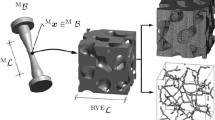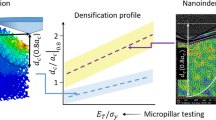Abstract
Soyarslan et al. [J. Mater. Res. 33(20), 3371 (2018)] proposed a beam-finite element model for the computation of effective elastic properties of nanoporous materials, where the ligament diameter along the skeleton is determined with the biggest sphere algorithm. Although this algorithm is often used in the literature, it is known that it systematically overestimates the diameter in network structures. Thus, the need for further stiffening of the junction zones as proposed by the authors is in contradiction to the literature. Furthermore, the factor 40 appears to be one order of magnitude too high. We show that the 3D microstructures generated from random Gaussian fields contain features that are violating the assumption of circular cross-sections and, therefore, cannot be captured by the biggest sphere algorithm. Consequently, the authors required an unphysically high value of 40 to compensate this hidden effect.


Similar content being viewed by others
References
N. Huber, R. Viswanath, N. Mameka, J. Markmann, and J. Weißmüller: Scaling laws of nanoporous metals under uniaxial compression. Acta Mater. 67, 252–265 (2014).
J. Jiao and N. Huber: Effect of nodal mass on macroscopic mechanical properties of nanoporous metals. Int. J. Mech. Sci. 134, 234–243 (2017).
B.-N. Ngô, A. Stukowski, N. Mameka, J. Markmann, K. Albe, and J. Weissmüller: Anomalous compliance and early yielding of nanoporous gold. Acta Mat er. 93, 144–155 (2015).
K. Mangipudi, E. Epler, and C. Volkert: Topology-dependent scaling laws for the stiffness and strength of nanoporous gold. Acta Mater. 119, 115–122 (2016).
K. Hu, M. Ziehmer, K. Wang, and E. Lilleodden: Nanoporous gold: 3D structural analyses of representative volumes and their implications on scaling relations of mechanical behaviour. Philos. Magaz. 96, 3322–3335 (2016).
K. Hu: Micromechanical and three-dimensional microstructural characterization of nanoporous gold–epoxy composites. Ph.D. thesis, Hamburg University of Technology (TUHH), 2017
C. Richert and N. Huber: Skeletonization, geometrical analysis and finite element modeling of nanoporous gold based on 3D tomography data. Metals 8, 282 (2018).
S. Soyarslan, S. Bargmann, M. Pradas, and J. Weissmüller: 3D stochastic bicontinuous microstructures: Generation, topology and elasticity. Acta Mater. 149, 326–340 (2018).
T. Hildebrand and P. Rüegsegger: A new method for the model-independent assessment of thickness in three-dimensional images. J. Microsc. 185, 67–75 (1997).
C. Richert, A. Odermatt, and N. Huber: Computation of thickness and mechanical properties of interconnected structures: Accuracy, deviations and approaches for correction. Front. Mat er. 6, 352 (2019).
A. Odermatt, C. Richert, and N. Huber: Prediction of elastic-plastic deformation of nanoporous metals by FEM beam modeling: A bottom-up approach from ligaments to real microstructures. Mater. Sci. Eng. A 791, 139700 (2020).
C. Soyarslan, H. Argeso, and S. Bargmann: Skeletonization-based beam finite element models for stochastic bicontinuous materials: Application to simulations of nanoporous gold. J. Mater. Res. 33, 3371–3382 (2018).
S. Bargmann, B. Klusemann, J. Markmann, J. Schnabel, K.S.C. Schneider, and J. Wilmers: Generation of 3D representative volume elements for heterogeneous materials: A review. Prog. Mater. Sci. 96, 322–384 (2018).
A. Stukowski: Visualization and analysis of atomistic simulation data with OVITO–the Open Visualization Tool. Modelling Simul. Mater. Sci. Eng. 18, 015012 (2010).
Acknowledgments
This work is funded by the Deutsche Forschungsgemeinschaft (DFG, German Research Foundation)–Projektnummer 192346071–SFB 986 Tailor-Made Multi-Scale Materials Systems: M3 project B4. J. Weissmüller is acknowledged for making the Mathematica script available published in [3] that allowed for reproducing the 3D microstructures. E.T. Lilleodden is acknowledged for discussions and editing of the manuscript.
Author information
Authors and Affiliations
Corresponding author
Rights and permissions
About this article
Cite this article
Huber, N., Richert, C. Comment to “Skeletonization-based beam finite element models for stochastic bicontinuous materials: Application to simulations of nanoporous gold” by C. Soyarslan et al. [J. Mater. Res. 33(20), 3371 (2018)]. Journal of Materials Research 35, 2831–2834 (2020). https://doi.org/10.1557/jmr.2020.257
Received:
Accepted:
Published:
Issue Date:
DOI: https://doi.org/10.1557/jmr.2020.257




